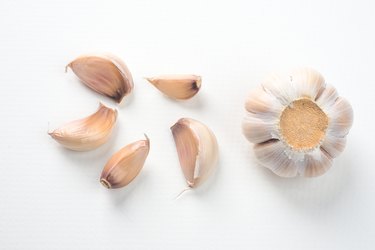
The benefits of garlic are many and varied. First of all, it's a delicious addition to so many savory dishes from every part of the world. Its health benefits are widely acknowledged. Regular garlic consumption at the rate of at least one clove a day can help your body prevent and fight against colds and flu, aid your cardiovascular system, reduce high blood pressure, and act as an anti-inflammatory agent. Research is being conducted as to its possible use as a cancer preventative, as well. It's good for you either raw or cooked, though some of its benefits are reduced a bit by cooking.
Selecting the Right Garlic
Video of the Day
You can buy packaged garlic juice in the supermarket, but like so many other things, it's so much better (and better for you) when it's fresh. To make garlic juice, you need raw garlic. You'll want fully robust bulbs firmly encased in unmarred skin. If you see shoots peeking out, the garlic isn't fresh. It doesn't hurt to ask the produce department manager of your supermarket where its garlic is sourced. China exports a huge amount of garlic, and a lot of it isn't in the best shape by the time it's processed and has arrived at your market.
Video of the Day
Garlic is also grown in the United States, much of it on the West Coast. California garlic is one of your best bets, though garlic from Mexico is also quite good. You can often find fresh California garlic at health food stores and even warehouse stores with large produce sections.
Juicing the Garlic
It's not an exact science, but the average garlic bulb has between 10 and 15 cloves that make between ¼ cup and 1/3 cup of juice, so, to make 1 cup of juice, you'll need four to six bulbs.
It's obvious that you'll have to use a large amount of garlic to come up with enough pure juice to make your efforts worthwhile. Peeling each clove individually can be tedious, but it cannot be avoided.
Some experts suggest bashing an entire bulb with a sturdy bowl and rolling the bowl around a bit to separate the cloves. Then, put the cloves in a lidded glass or hard plastic container and shake it like there's no tomorrow. After some energetic shaking, you'll see that the skins of the cloves have come loose. From there, it's easy to simply slide off the skins and get to work extracting the juice.
Put the cleaned-up cloves in your blender or juicer and let them whir for a few minutes, or until they reach a pasty consistency. Remove them, scraping out any of the juicy pulp that remains at the bottom or sides. Place the paste into a mesh strainer and rest the strainer on top of a bowl while you press it down. Don't worry about a little pulp coming through; you're not done yet.
After you've pressed out as much juice as you can, find another bowl or a drinking glass and secure a regular coffee filter over the top with a rubber band. Now, pour your already once-strained juice through the filter. This will take some time, but it will be worth it. By the end, you'll have produced some genuine fresh garlic juice.
Storing and Using Garlic Juice
Save any leftover pulp to punch up your next savory entree. The juice itself can be stored in the freezer. Pour a few teaspoons into each compartment of a mini-muffin tin; then cover it up. Whenever you want garlic juice, you'll have some ready to go.
Now that you've got your juice, what can you do with it? Quite a lot, as it turns out. It's an easy way to add garlic to smoothies, salad dressings, vegetables, stir-fries, casseroles, soups and stews.
You can make a garlic drink by diluting the juice with water, adding honey and fresh lemon juice to taste and serving it up as a tonic, or brewing it as a tea. Another use is as an "immunity garlic shot" to ward off colds. Pour a teaspoon or two of garlic juice into a shot glass; add the juice of one lemon and a pinch of cayenne pepper. Get it down the hatch fast, and be ready with a water chaser! You can repeat this a few times a day.
Garlic Juice in the Garden
Garlic juice can help you keep your garden safe from insect pests without contaminating the soil or poisoning larger, furrier animals. Mix 1/4 cup of garlic juice with 3 quarts of water; add a few squirts of potash-based dishwashing soap, and you're ready to spray. Not only is garlic an effective insect repellent, it also acts as a fungicide.
Try to use your garlic spray soon after you've prepared it: It loses its power over time. It's what is known as a "broad-spectrum" repellent, which means that you should focus your attention (and your spray) only on active infestations of bad bugs and leave those good bugs alone.